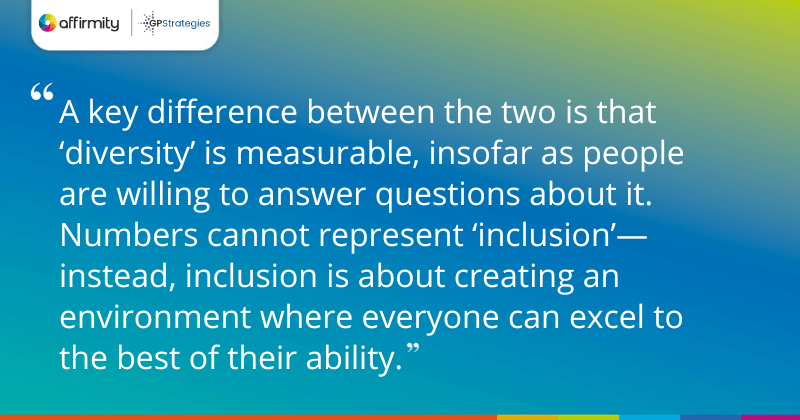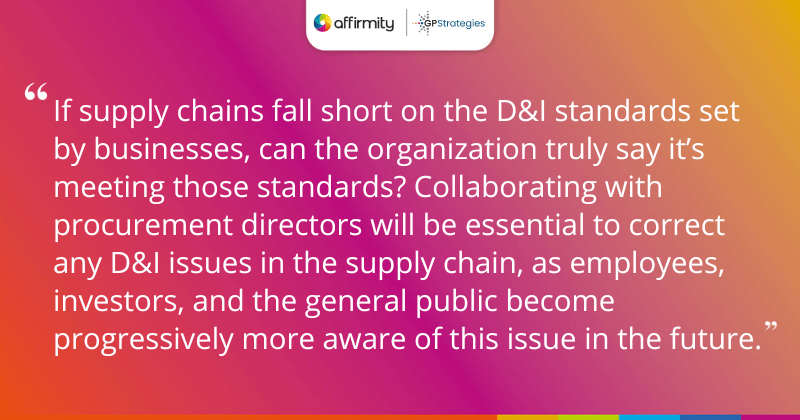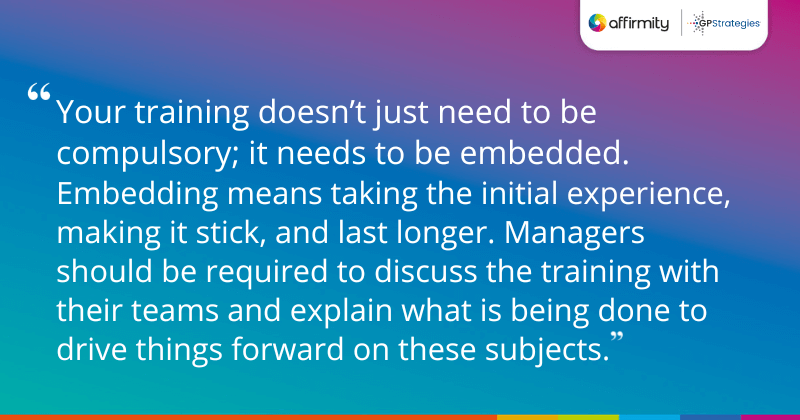If your organization is serious about inclusion, there are nine points of leverage that you should already be exploiting in order to achieve your goal. Check that you’re on track with the tips in this article from Angela Peacock, Global Director D&I, GP Strategies (an Affirmity inclusion training partner), and explore a truly inclusive workforce.
It could be observed that, at the current rate of progress on inclusion, it’s likely that our great-granddaughters will be the first of our descendants to have the same opportunities as their male siblings. And then, this is likely only if they’re Caucasian, not living with a disability, and heterosexual. If not, equality may be delayed another generation still.
This is all despite the reality that inclusion is increasingly a significant differentiator for employees, and the fact that there’s a wide range of research that suggests that closing gaps would benefit everyone. For example, in 2015, McKinsey estimated that closing the gender gap alone would add $28 trillion to the global economy by 2025.
It will take significant effort for organizations to shorten the generational pace of change required, but it can—and should—be achieved. Here are nine essential inclusion “levers” that we believe every organization should be pulling on.

1. Define Your Language
The world at large is so used to using ‘diversity and inclusion’ (D&I) as a single phrase that it sometimes seems like the two ideas aren’t actually distinct. While it’s important that a strategy considers both diversity and inclusion (and equity and belonging for good measure), it’s important to differentiate their meanings in order to acknowledge their separate effects on your business.
A key difference between the two is that ‘diversity’ is measurable, insofar as people are willing to answer questions about it. Numbers cannot represent ‘inclusion’—instead, inclusion is about creating an environment where everyone can excel to the best of their ability.
FURTHER INSIGHTS FROM THE BLOG | ‘What is Fair Pay? And What’s the Difference Between Equity and Equality?’
2. Get the C-Suite to Commit
A commitment to diversity and inclusion isn’t just about saying all the right things: words need to be backed by actions, and actions must be backed by budgets. Your D&I leaders won’t be able to affect real change if they’re operating with a shoestring budget and unable to hire and consult experts.
Furthermore, that leader should be reporting to senior management, ideally the CEO. When you’re serious about D&I you’re not only well-financed—you’re accountable too.
3. Empower D&I and HR
On the subject of accountability, ensure that where councils, committees, and ERG groups are used as an engine for inclusion, accountability exists to steer them towards meaningful and positive outcomes. Make sure that you emphasize the direct line between their activity and business outcomes—have them draw up a comprehensive business plan, detailing specific impacts they can have on the organization.
MORE ON EMPLOYEE RESOURCE GROUPS | ‘5 Virtual ERG Lessons Learned From Lockdown’

4. Befriend Your Procurement Director
Sustainability and anti-modern slavery measures both fall within the remit of procurement directors, who have ensured that organizations fulfill their legal and moral obligations to both. The same should be done for diversity and inclusion—if supply chains fall short on the D&I standards set by businesses, can the organization truly say it’s meeting those standards?
Collaborating with procurement directors will be essential to correct any D&I issues in the supply chain, as employees, investors, and the general public become progressively more aware of this issue in the future.
5. Communicate the Business Case
The case made for inclusion can sometimes rely too heavily on theoretical, difficult-to-measure benefits—particularly, the idea that creativity and innovation will increase as a result of greater diversity in our organizations. The idea is appealing and intuitively makes sense. After all, the more influences and ways of thinking, the greater the diversity of thought available to you.
However, business leaders aren’t always receptive to ideas that spring from intuition alone, especially if after years of being told something is the case, they lack empirical evidence. While these emotive ideas have their place, the business case for inclusion needs to better highlight specific, bottom-line benefits that your leaders should expect to see—benefits that may need measurement to prove. For example, you may want to forecast and show how you intend to prove an increase in market share, a campaign to a specific group that worked well, or even an enhanced result in safety or compliance records.
6. You Can and Should Measure Inclusion
It’s sometimes said that inclusion is a soft option that is essentially unmeasurable. We would dispute this. Measuring is a critical step towards proving something, and the tools do exist to bring a meaningful degree of measurement to your programs. Specifically, we recommend using:
- Employment engagement surveys
- Hiring numbers
- Talent velocity (the speed at which diverse talent permeates through your organization).
MORE MEASUREMENT IDEAS | ‘How to Use a Climate Survey to Understand and Nurture Diversity and Inclusion’

7. Go Beyond Quotas
With a specific quota to reach, a manager will know to, for example, put pressure on recruitment agencies and measure the number of diverse candidates they hire from them. Nonetheless, it may actually be more effective to encourage inclusive behaviors, and use managers to set the tone for inclusive best practices across the business.
Encourage and build opportunities for leaders to demonstrate these behaviors: emphasize that being an ally and attending ERGs meetings, or committing to mentoring someone with different demographic characteristics will build a more stable, inclusive environment in the long term.
8. Make Training Mandatory and Embedded
In the firepit of your organization’s inclusion plan, mandatory training on subjects such as unconscious bias is a lot like log fuel: even when it’s of suitably high quality, it needs kindling to catch alight. Your training doesn’t just need to be compulsory; it needs to be embedded.
Embedding means taking the initial experience, making it stick, and last longer. Managers should be required to discuss the training with their teams and explain what is being done to drive things forward on these subjects.
This can be through a series of monthly actions or conversations with others, a short video reminder, or perhaps a “nudge” that lands in your inbox at an optimal time.
9. Discover Your “Pinch Points”
Bias can be particularly prominent at specific “pinch points” in your process. Work on filtering out that bias at those points, and the effect will be greatly reduced overall. For example, lengthy hiring criteria may not filter out competency alone—the closer you can get to the bare essentials of what’s required in the job, the more diverse your group of candidates may be. A similar reappraisal of interviews may also be helpful.
FROM OUR ARCHIVES | ‘3 Key Ways to Build a Culturally-Aware Climate in Your Organization’
Conclusion
Each of these nine levers is critical for the functioning of your inclusion plan. In fact, you could make the case that if there isn’t a hand on every single one simultaneously, then you’re not really building towards inclusion. After all, you can no more do a “little bit of inclusion” than you can be “a little bit pregnant”. Therefore, ensure that each of the levers has your attention, and the attention of key stakeholders in your business.
Need help identifying which of the nine levers your organization isn’t yet leaning on? Contact us today and start building a truly inclusive DE&I program.
 About the Author
About the Author
Angela Peacock is the Global Director of Diversity and Inclusion at GP Strategies. Through the work of hundreds of clients across 20 years of global DE&I experience, Angela has seen the good, the bad, and the downright idiotic: she pulls no punches and has learned that by having frank, strategic, and not just well-meaning conversations, organizations can drive better results and excel in terms of diversity, inclusion, and business performance.
